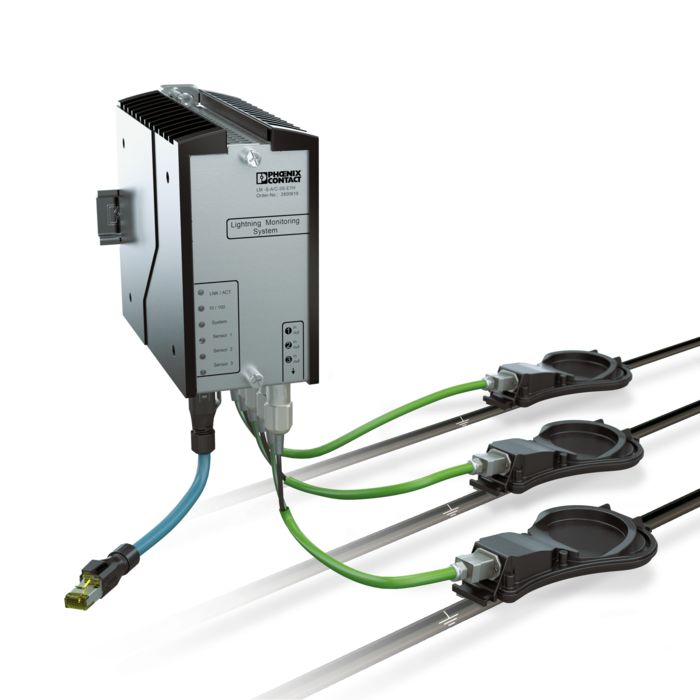Lightning monitoring system <h3>Record and evaluate lightning currents</h3> Lightning strikes cause devastating damage to buildings and systems. Our LM-S lightning monitoring system provides the solution for recording and evaluating lightning strikes in exposed or widely distributed systems.

Find out here how the lightning monitoring system works and discover the possible areas of application.

Lightning monitoring system
The LM-S lightning monitoring system detects and analyzes all significant parameters of lightning surge currents. Up to three sensors are connected to one evaluation unit. The sensors are mounted on down conductors of a lightning protection system. The measurement in the sensors is based on a magneto-optic effect known as the Faraday effect. To avoid any influence on the measurement, fiber optics are used to transmit signals from the sensor to the evaluation unit.
Further information on the sensors and other components can be found on the detailed product page.

LM-S lightning monitoring system
Hermes Award 2012 for the lightning monitoring system
In 2012, the lightning monitoring system won the Hermes Award, a highly-coveted international technology award.
Since 2004, the Hermes Award has been awarded annually by Deutsche Messe AG for outstanding and innovative products.

Secondary damage and destruction resulting from lightning strikes
Depending on the energy involved, lightning strikes can result in extensive destruction to buildings and systems, which can result in further, secondary damage.
In terms of residential or commercial buildings, which are regularly frequented by people, such damage is immediately noticed. Remedial measures to limit the damage can normally be initiated rapidly. Following such an event, the extent of the damage can be evaluated quickly and precisely. Immediate repair and recommissioning of important system functions can prevent consequential damage.
It is normally not possible for employees to continuously monitor exposed or large-scale systems. Damage or destruction is often only detected once secondary damage has occurred. As a result, smart monitoring systems are increasingly being used. They constantly monitor the various functions and their status in a system and send the results directly to a central control unit. This enables an immediate response in the event of a malfunction and prevents secondary damage as well as long downtimes.
Up to now, there was no measuring system which could be used to reliably detect and evaluate lightning strikes on a system. As such, there was no damage or fault reporting of such events.
Systems that are particularly at risk of lightning strikes are those in exposed locations, such as wind turbine generators, power generation systems, large-scale industrial plants, and railway systems. In such systems, complete lightning protection is generally very difficult, and even sometimes impossible, to implement.

Lightning monitoring system
LM-S lightning monitoring system
The LM-S lightning monitoring system for the detection and evaluation of lightning strikes is available from Phoenix Contact. It essentially consists of an evaluation unit and a sensor, which is mounted on the down conductor of a lightning protection system.
To analyze the level and flow direction of lightning surge currents that occur in lightning down conductors, this monitoring system utilizes the Faraday effect or the magneto-optic effect. In this process a light wave is magnetically influenced and the influencing value is evaluated as a measuring result. The signal transmission also takes place via fiber optics.
This offers clear advantages over signal transmission via copper cables. Lightning currents, which occur in the vicinity of the measuring system, are unable to influence the light signal or couple into the transmission path. This means that the evaluation unit electronics receive a reliable and, from an EMC perspective, harmless, signal.
Functional principle
How can lightning current be measured? How do surge voltages occur? How do surge voltages get into your devices and systems? You've probably wondered about the answers to these questions. Comprehensive information on lightning current detection is provided below.
Structure of the measuring path
The measuring path consists of a transparent medium (dielectric) with polarizers or polarizing filters fitted at either end. The measuring path is positioned at an angle of 90° to the current flow direction in the down conductor. In this way, the propagation direction of a light wave in the measuring path lies parallel to the magnetic field of the surge current in the down conductor.

Linear polarizer
Polarizers
Polarizers or polarizing filters are optical elements which produce polarization. To do this, electromagnetic waves are separated into linear, elliptical or circular polarized light through absorption or beam splitting. In this case, the light is linearly polarized in order to use the Faraday effect. This means that only linearly polarized light passes through the polarizing filter.

Magnetic effect on the plane of polarization
Magnetic effect on the plane of polarization
The light wave causes the electrons in the dielectric to oscillate. The magnetic field changes the movement of the electrons within the dielectric. This in turn influences the plane of polarization of the light. In principle, the plane of polarization can be rotated in any direction.

Magneto-optic effect in the LM-S
Magneto-optic effect in the LM-S
The graphical model shows all the important elements and variables of the magneto-optic effect in the lightning monitoring system. A light wave Φ with a defined light intensity is guided onto the measuring path via fiber optics.
The polarizing filter P1 at the input of the measuring path linearly polarizes the directed light. The light wave polarized in this way causes the electrons in the medium to oscillate and travels through the measuring path medium in the plane of polarization. The plane of polarization can be influenced magnetically.
The magnetic field of a surge current rotates the plane of polarization of the light wave within the medium around the longitudinal axis. The direction of rotation depends on the direction of the magnetic field lines and thereby the direction of the current flow. For example, surge currents from negative and positive lightning create magnetic field lines with different directions.
The greater the current I, the stronger the magnetic field B and the greater the angle of rotation β. The magnetic field B1 causes clockwise rotation and magnetic field B2 causes counterclockwise rotation of the light wave.
The second linear polarizing filter P2 is positioned at the output of the measuring path at an angle of 45° to the input polarizing filter. Only 50% of the light from an uninfluenced light wave thereby passes through the output polarizing filter. The amount of light that passes through the output polarizing filter is dependent on the rotation of the light wave. This results in a measurable light signal which can also be evaluated.

Schematic diagram: change in the amount of light that passes through the output polarizing filter
Measuring result and evaluation
Positive lightning results in clockwise rotation of the polarized light signal. The amount of light that passes through the second polarizing filter increases and amounts to between 50% and 100%. When the angle of rotation of the light signal reaches 45°, this corresponds to a measured value of 100% for a positive lightning strike.
Negative lightning results in counterclockwise rotation of the polarized light signal. The amount of light that passes through the second polarizing filter decreases and amounts to between 50% and 0%. When the angle of rotation of the light signal reaches -45°, this corresponds to a measured value of 100% for a negative lightning strike.
The amount of light that makes it through the output polarizing filter is measured. The typical parameters of the monitored lightning surge current are derived from the progression of the amount of light over time. These are the maximum current strength, lightning current rate of rise, charge, and specific energy.
Influencing variables
The important influencing variables are the medium’s material, the wavelength of the light, the length of the light path through the medium, and the strength of the magnetic field. Further theoretical principles and influencing variables are explained below.
Electric field vector E
The electric field vector E describes the progression and the position of the affected light wave. It is represented by an arrow (see graphical model).
Dielectric
Any weakly or non-conductive, non-metal substance whose charge carriers generally cannot move freely is referred to as a dielectric. This can be a gas, a liquid or a solid. These substances are typically non-magnetic and are acted upon by electrical or electromagnetic fields.
Verdet constant V
The Verdet constant V corresponds to the rotation per unit of the magnetic flux density. It describes the strength of the Faraday effect for the dielectric to be evaluated. Its value depends on the wavelength of the electromagnetic waves in the medium.
Calculation of the angle of rotation β
The angle of rotation β, about which the plane of polarization rotates, is calculated by:
β = V x d x B
d is the length of the light path through the medium, B is the magnetic flux density, and V is the Verdet constant.

Circular magnetic field around the sensor
Installation
In a circular magnetic field, the effective field strength depends on the depth of immersion of the sensor in the magnetic field of the current-carrying down conductor.
For the calculation, the immersion depth is defined via the radius. This means that the smaller the radius, the greater the field strength. To ensure that the effective field strength is as great as possible, it is advisable to mount the sensor on the down conductor as tightly as possible.
Key:
H = field strength [A/m]
r = radius [cm]
I = current [A]

The measuring path is located in the front part of the sensor housing.
Importance of the radius for system calibration
The radius is the measurement for the immersion depth of the sensor in the magnetic field and for recording the effective magnetic field strength H there. The value corresponds to the distance from the center line of the conductor to the outer edge of the sensor housing.
The radius is determined during installation. This is important for the calibration of the system, as it ensures the same measurement conditions for different system conditions.
Signal transmission and monitoring
How does the detected signal travel from the sensor to the evaluation unit? How are the measuring results evaluated there? How can the system minimize maintenance? You will find the answer below.

RJ45 Ethernet interface
System interfaces and signal transmission
The evaluation unit can be integrated into standard networks via the RJ45 Ethernet interface. An internal web server is used to access the recorded data and configure the system. The web interface is opened via the Internet browser on a PC connected to the system using IP addressing.

Display of load values on a cell phone
Remote monitoring and preventive maintenance
Lightning strikes on systems that are difficult to access or are remote, such as offshore wind farms, are impossible or extremely difficult to detect. The LM-S lightning monitoring system provides you with all the measuring data via an integrated web interface. This means that you can determine the load situation of the system at any time by means of remote access, e.g., using a cell phone.
The evaluated data allows you to precisely estimate the actual system load. The measuring results are always up to date and enable predictive maintenance to be carried out. If damage to the system is indicated, you can initiate rapid measures to prevent secondary damage. Downtimes can then be reduced or completely avoided. If the measuring results indicate minimum, uncritical system loads, this also saves unnecessary maintenance work or servicing.

Assignment of the remote contact
Remote contact
The evaluation unit also has a switching relay with accessible remote contact. For each event, this N/C contact produces a short pulse, which can be evaluated by a counter. In this way, it is also possible to carry out a simple or additional evaluation of the number of lightning strikes on the system. The relay contact only assumes its normal position once the system is started up. And in the event of a system malfunction, the relay drops out. As such, system availability is queried via the remote contact.
Application examples
A few examples of applications that can be implemented with the lightning monitoring system are provided below.
Wind turbine generators
Exposed wind turbine generators, such as offshore wind farms, are particularly at risk of lightning strikes. In such systems, complete lightning protection is generally very difficult to implement, even impossible. The lightning monitoring system is ideal for such cases.
The figure shows the arrangement of the individual system components in a wind turbine generator. A sensor is mounted on each lightning arrester on the rotor blades. The evaluation unit is located in a control cabinet in the hub. The signals are transmitted between the sensors and the evaluation unit via fiber optics. The Ethernet connection to the central controller is established via slip rings between the nacelle and the observation deck. The evaluation unit works with 24 V DC voltage.
If required, the remote contact can be connected to the controller. This makes it possible to signal every lightning strike or evaluate the number of events.

Schematic diagram of an LM-S application using the example of a wind turbine generator

LM-S at the Hermann monument in Detmold, Germany
Cultural monument
This application example shows how the lightning monitoring system is used at the Hermann monument in Detmold, Germany. The copper statue stands on a sand-lime brick base. Three grounding cables are connected to the base of the statue. This means that if the structure, which is over 53 m tall in total, is hit by a lightning strike, the lightning surge currents are discharged to ground. The sensors are mounted on these down conductors. The evaluation unit is installed in a control cabinet inside the base.
Substation
Lightning strikes on high-voltage cables result in transformer loading in power transformation substations. Often surge protection elements are connected upstream of transformers. These direct the surge currents from coupled overvoltages to ground. In the past, spark gaps were normally used as protective elements. In recent years, varistors have become the preferred solution.
The LM-S allows you to detect and evaluate the actual load of the protective elements. This ensures early monitoring of load limits and replacement of affected protective elements.
The sensors are installed on the down conductors between the protective elements and the ground. Fiber optics transmit the measurement signals to the evaluation unit, which is installed in a remote control cabinet.

Schematic diagram of an LM-S application using the example of a substation
